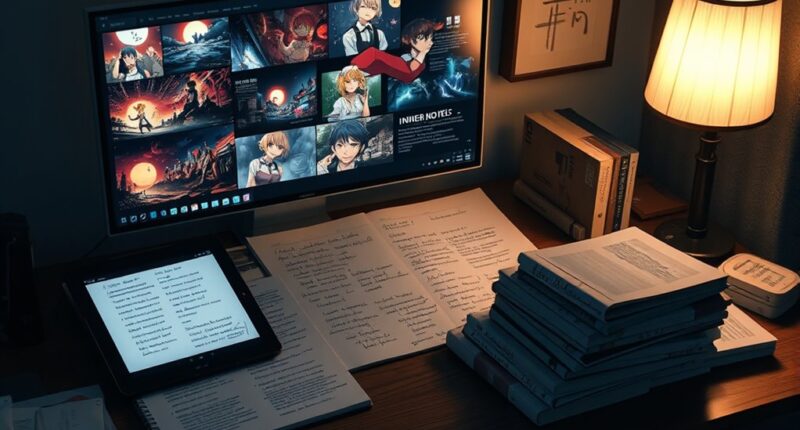When adapting a light novel’s inner monologues into anime, you’ll use visual storytelling—like expressive faces, symbolic imagery, and dynamic angles—to show characters’ thoughts and feelings. Voiceovers, narration, and sound design help connect viewers with internal worlds, while clever use of colors and metaphors deepen emotional impact. Balancing these elements guarantees inner thoughts come alive vividly on screen. Keep exploring, and you’ll discover even more techniques to translate internal dialogue into engaging visuals.
Key Takeaways
- Use visual cues like facial expressions, body language, and symbolic imagery to imply internal thoughts without explicit narration.
- Incorporate sound design, such as whispers, ambient sounds, and musical cues, to suggest internal dialogue and emotional states.
- Employ narration to directly convey inner monologues, providing clarity and emotional depth to the character’s thoughts.
- Utilize visual metaphors and symbolic imagery (e.g., blooming flowers, cracked mirrors) to represent internal conflicts and growth.
- Blend layered visuals, sound effects, and innovative framing techniques (like dynamic angles) to immerse viewers in the character’s internal world.
The Role of Inner Monologues in Light Novels
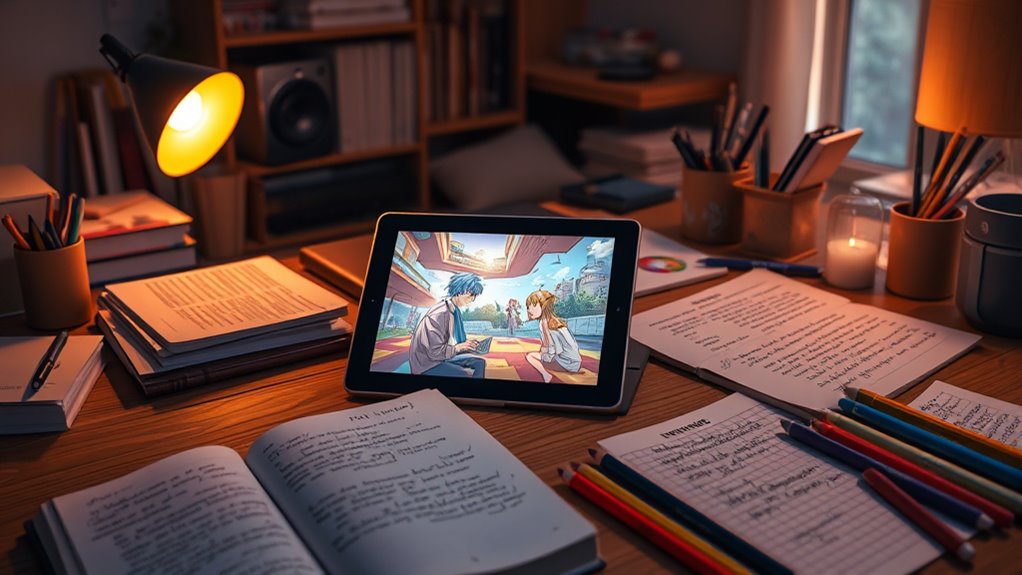
Inner monologues play a crucial role in light novels by providing direct insight into a character’s thoughts and emotions. They’re essential for character development, allowing you to understand motivations, doubts, and desires more intimately. This deepens your connection with the character and enriches the story. Additionally, inner monologues influence narrative pacing by controlling how quickly or slowly the story unfolds, giving you moments of reflection amid action. They create a layered experience, blending external events with internal reactions. By showcasing a character’s internal dialogue, light novels maintain a steady rhythm that balances dialogue, narration, and introspection. This technique makes characters feel more real and complex, setting the stage for compelling storytelling that’s both engaging and emotionally resonant. Incorporating inner monologue techniques can also help adapt stories more effectively when translating from light novels to anime, as they provide a foundation for voice acting and visual cues.
Challenges in Conveying Internal Thoughts in Animation
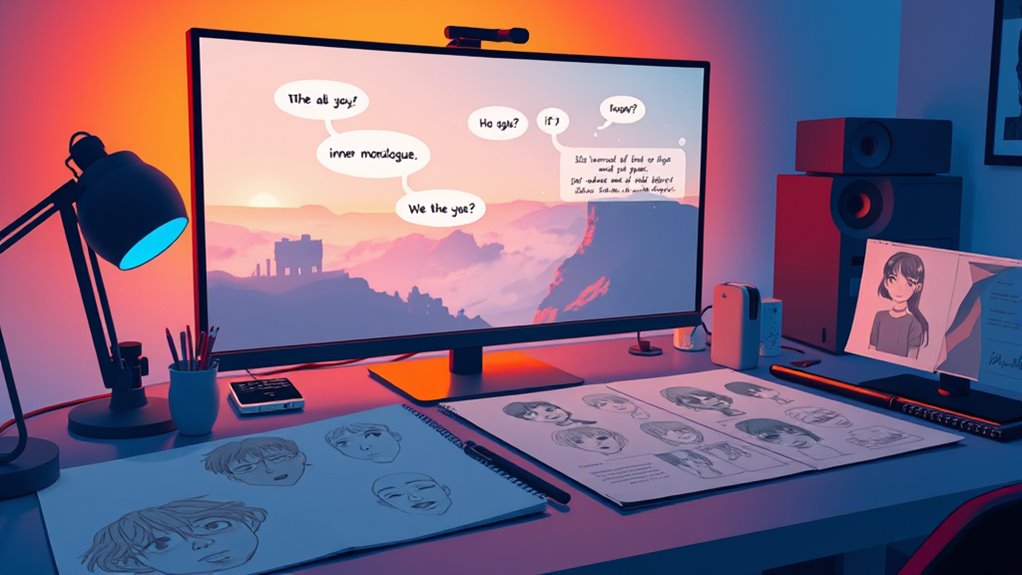
Conveying a character’s internal thoughts in animation presents unique challenges because you can’t simply rely on text or narration like in light novels. Instead, you must use visual storytelling techniques, such as facial expressions, body language, and shot composition, to reveal inner emotions and conflicts. Sound design also plays a vital role; subtle background music, breathing, or internal sounds can hint at a character’s mental state without overwhelming the scene. Balancing these elements is tricky—overuse can feel heavy, while underuse may leave viewers clueless. The goal is to create an immersive experience that intuitively communicates inner monologues without explicit exposition. This requires careful coordination between animation, sound, and timing to ensure the audience understands what’s happening inside the character’s mind. Additionally, understanding how contrast ratio impacts image clarity can help animators decide how visual elements should be emphasized to convey mood effectively.
Visual Techniques for Representing Inner Dialogue

Visual techniques are vital for illustrating a character’s internal dialogue without explicit narration. You can use visual symbolism, like changing backgrounds or lighting, to reflect a character’s emotions or thoughts subtly. For example, a flickering light might indicate inner turmoil, while a bright glow suggests clarity. Additionally, sound design plays a crucial role; internal monologues can be emphasized with whispering voices or ambient sounds that fade in and out, signaling private thoughts. These methods allow viewers to intuitively grasp what’s happening inside a character’s mind without relying on dialogue or text. By combining visual symbolism and sound design thoughtfully, you create a layered, immersive experience that makes internal dialogue feel natural and compelling, aligning the audience’s emotional perception with the character’s inner world. Incorporating visual symbolism like color shifts or symbolic imagery can further deepen the audience’s understanding of a character’s mental state.
Using Narration to Bridge the Gap
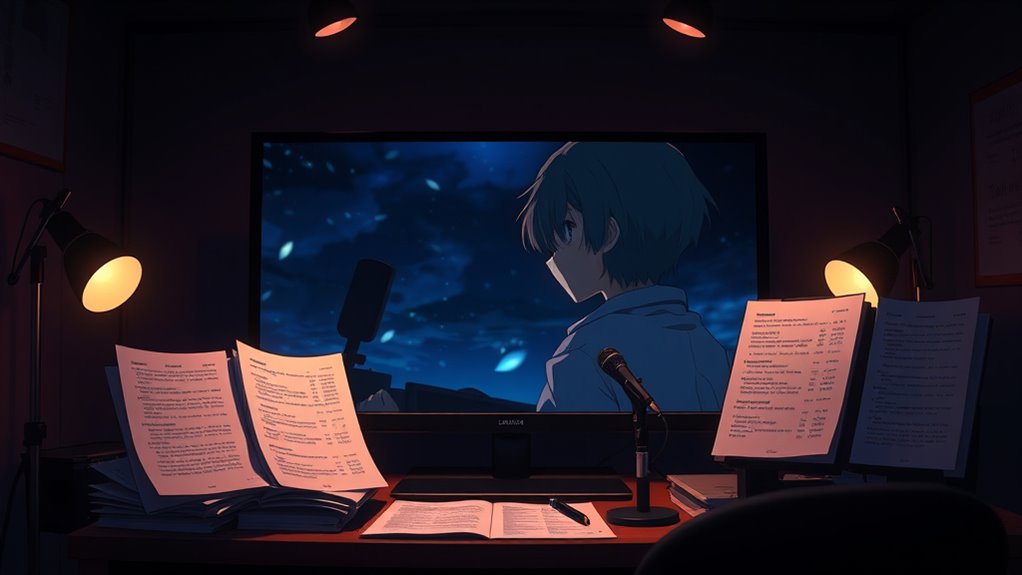
Using narration allows you to directly convey a character’s inner thoughts, making their emotions more accessible to viewers. It also adds emotional depth by highlighting subtle feelings that might be missed visually. When used effectively, narration creates a seamless connection between the audience and the character’s internal world. Incorporating techniques from remote hackathons can inspire creative ways to present internal monologues in a dynamic and engaging manner.
Conveying Inner Thoughts
When characters’ inner thoughts are difficult to show through visuals alone, narration becomes a crucial tool for bridging that gap. You can use audio cues, like subtle sound effects, to emphasize shifts in mood or inner conflict. Musical scoring also plays a vital role, setting the tone and hinting at unspoken feelings. A well-placed narration can directly convey what a character is thinking, providing clarity without breaking the scene’s flow. It allows viewers to connect more deeply with characters’ internal struggles, especially when visual cues are limited. Additionally, understanding how limits can inspire creative solutions helps in crafting more impactful storytelling techniques. By carefully blending narration with sound design and music, you create an immersive experience that makes inner monologues accessible and impactful for your audience.
Enhancing Emotional Depth
Have you ever felt that a scene’s emotional impact falls flat without a clear window into a character’s mind? Using narration effectively can deepen that emotional connection, making viewers feel closer to the characters. Integrating music enhances this effect, aligning melodies with the character’s inner state to amplify feelings. For example, soft, melancholic tunes can underscore loneliness or regret, while energetic beats highlight determination. This technique also bolsters character development by revealing nuanced emotions that dialogue alone can’t express. When done right, narration becomes a bridge, connecting viewers to a character’s internal struggles and hopes. By carefully combining music integration with inner monologues, you create a richer, more immersive experience that captures the full spectrum of human emotion.
Voiceovers and Their Impact on Storytelling
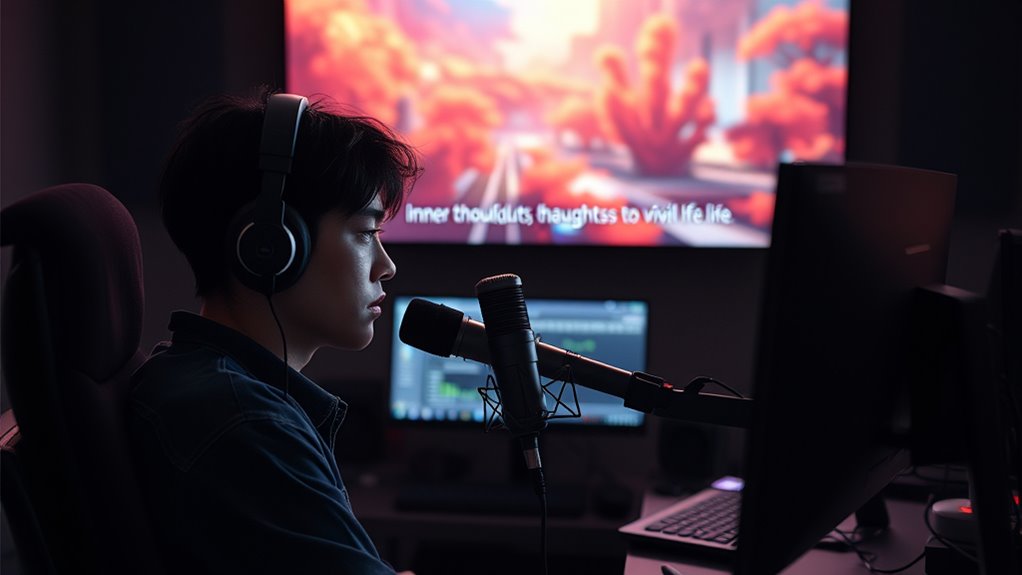
Ever wondered how voiceovers shape the way stories are told in anime? You’ll find that effective voiceover techniques deepen your connection to characters’ inner worlds, making their thoughts more accessible. Voiceovers allow you to hear what characters are truly thinking, providing clarity and insight that dialogue alone might miss. Sound design plays a essential role here, as subtle background effects or ambient sounds enhance the mood and emphasize key moments. When used skillfully, voiceovers can heighten tension, evoke empathy, or reveal hidden motives. They help bridge the gap between inner monologue and visual storytelling, making abstract thoughts tangible. In this way, voiceovers influence your perception, adding layers of meaning that elevate the emotional impact of the narrative.
Creative Use of Facial Expressions and Body Language
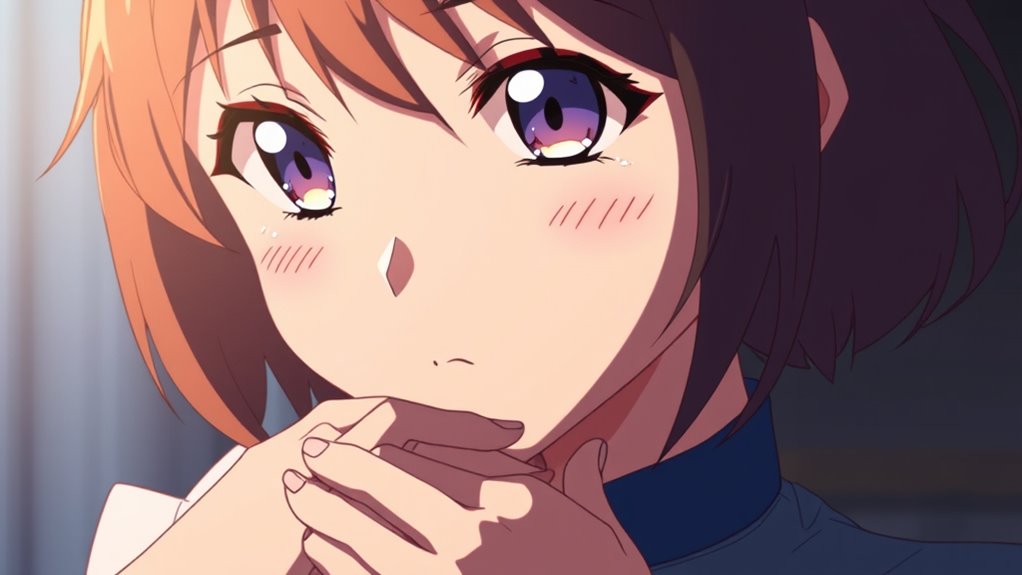
Voiceovers reveal what characters think, but their true emotions often show through facial expressions and body language. You’ll notice subtle facial cues—like a twitching eye or a tight jaw—that convey unspoken feelings. Body language also plays a vital role: a slouched posture hints at defeat, clenched fists suggest anger, and a hesitant step reveals doubt. These visual cues shape your understanding beyond dialogue and voiceovers. To enhance storytelling, animators emphasize:
- Microexpressions that flash across a character’s face, revealing fleeting emotions.
- Gestures like hand tremors or fidgeting, indicating nervousness or inner conflict.
- Posture changes that reflect shifting moods or realizations.
- Recognizing emotion cues helps viewers interpret complex character feelings more effectively.
Integrating Symbolism and Visual Metaphors
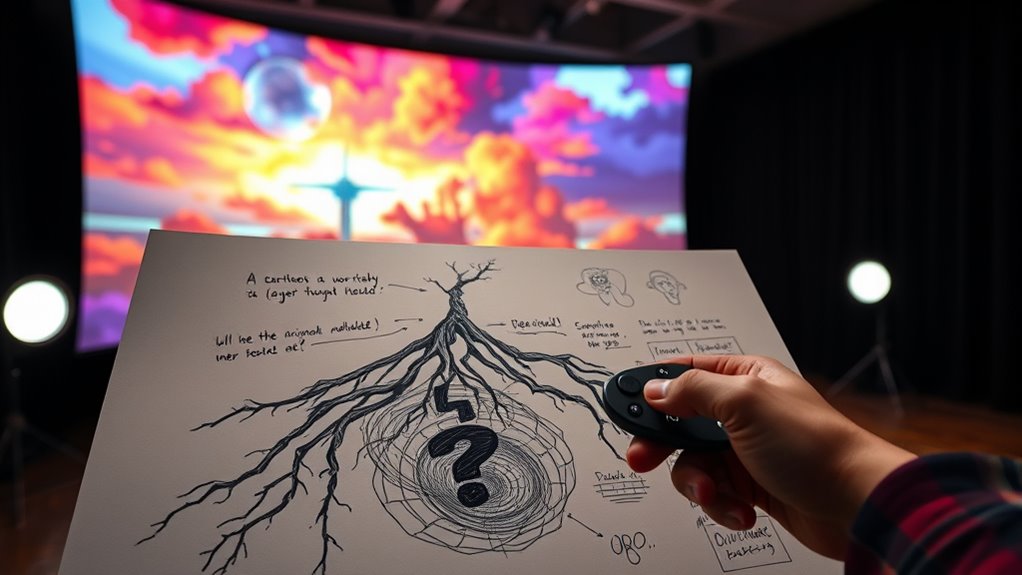
Integrating symbolism and visual metaphors allows anime creators to convey complex emotions and themes without relying solely on dialogue. You can use color symbolism to reflect characters’ moods or inner struggles—like cool blues signaling calm or sadness, and fiery reds representing passion or anger. Visual metaphors, such as a wilting flower symbolizing loss or decay, deepen emotional impact without words. By carefully choosing imagery, you help viewers interpret characters’ internal worlds intuitively. Here’s a quick comparison:
| Symbolism/Metaphor | Effect on Audience |
|---|---|
| Red flames | Passion, rage |
| Blue rain | Sadness, reflection |
| Cracked mirror | Identity crisis, broken self-image |
| Blooming cherry | Hope, renewal |
| Shadowy figure | Fear, hidden secrets |
This approach enriches storytelling, making inner monologues more vivid and resonant. Additionally, incorporating visual metaphors can effectively symbolize characters’ internal conflicts and growth throughout the narrative.
Balancing Fidelity and Artistic Interpretation
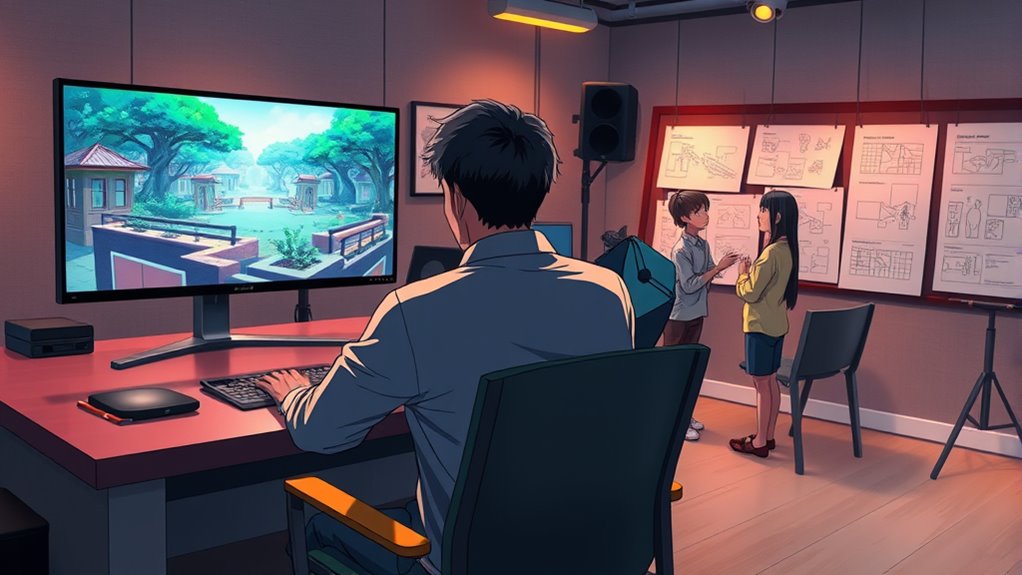
Striking the right balance between fidelity to the source material and artistic interpretation is essential for creating compelling anime that resonate with viewers. You want to honor the inner monologue‘s essence while enhancing visual storytelling and maintaining narrative pacing. Consider these approaches:
- Use visual cues—like subtle expressions or background details—to reflect inner thoughts without over-explaining.
- Adapt key phrases or themes from the novel, but reframe them to fit the animation’s rhythm.
- Incorporate visual metaphors or symbolic imagery to deepen viewers’ understanding without disrupting flow.
- Remember that visual consistency plays a crucial role in maintaining immersion and conveying character emotions effectively.
Examples of Effective Inner Monologue Adaptations
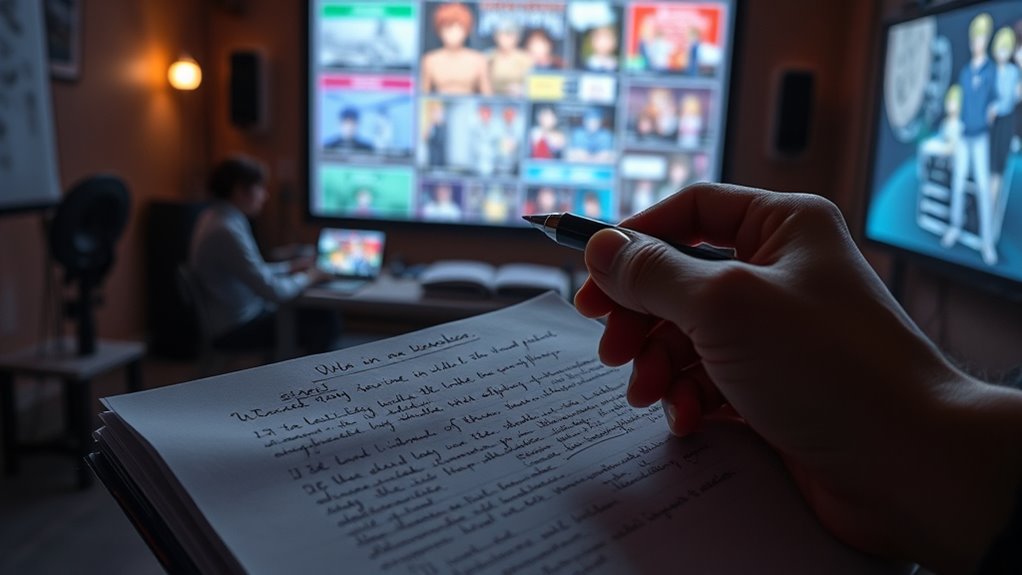
Effective inner monologue adaptations often showcase how visual storytelling can vividly capture a character’s internal world. Shows like “Monogatari” use dynamic camera angles, expressive facial expressions, and symbolic imagery to convey complex thoughts without relying solely on dialogue. In “March Comes in Like a Lion,” subtle visual cues and color palettes reflect the protagonist’s emotional state, deepening audience engagement. “The Melancholy of Haruhi Suzumiya” employs innovative framing and visual effects to depict internal conflicts creatively. These examples demonstrate that effective adaptations do more than just translate words—they craft visual experiences that immerse viewers in characters’ minds. By leveraging visual storytelling, creators can make inner monologues more relatable and compelling, strengthening emotional resonance and keeping the audience engaged throughout the story. Additionally, incorporating visual symbolism inspired by water park attractions, like flowing water or wave imagery, can enhance the portrayal of internal struggles and moments of clarity.
Future Trends in Depicting Inner Monologues in Anime

As technology continues to evolve, anime creators are exploring innovative ways to depict inner monologues more vividly and immersively. These technological innovations aim to boost audience engagement by making characters’ thoughts feel immediate and personal. Future trends include:
Anime technology advances are transforming inner monologue visualization, enhancing immersion and emotional connection for viewers.
- Augmented Reality overlays that visualize inner thoughts directly on the screen, creating a seamless connection between character and viewer.
- Dynamic sound design combining whispers, echoes, or internal voice modulation to convey mood shifts and internal conflicts.
- AI-driven visual effects that adapt in real-time to character emotions, intensifying inner monologues during pivotal moments.
- Embracing space optimization techniques can help studios allocate resources more efficiently for implementing these advanced effects.
These advancements promise richer storytelling, keeping viewers more engaged and emotionally connected with characters’ inner worlds, pushing the boundaries of traditional anime narration.
Frequently Asked Questions
How Do Writers Decide Which Inner Thoughts to Adapt Visually?
When deciding which inner thoughts to adapt visually, you focus on key moments that reveal character motivations or plot twists. You use visualization techniques like text overlays or symbolic imagery to make these thoughts engaging. Your goal is to enhance audience engagement by selectively highlighting the most impactful inner monologues, ensuring viewers connect emotionally without overwhelming them. This balance helps convey depth while keeping the story dynamic.
What Are Common Mistakes When Translating Monologues Into Visual Storytelling?
About 65% of viewers feel that poorly translated monologues break immersion. When translating inner thoughts into visuals, common mistakes include neglecting visual consistency, which confuses viewers, and disrupting pacing balance, making scenes feel rushed or sluggish. You might overuse voiceovers or fail to match visuals to the tone, losing emotional impact. Focus on maintaining visual harmony and pacing to guarantee the inner monologue enhances, rather than hinders, storytelling.
Can Inner Monologues Be Effectively Conveyed Without Narration or Voiceovers?
You can effectively convey inner thoughts without narration by using visual symbolism that hints at characters’ feelings, making the audience engage more deeply. Subtle facial expressions, body language, and environmental cues reveal their inner world, creating a natural flow. This approach draws viewers in, encouraging them to interpret emotions themselves, which enhances audience engagement and offers a more immersive experience without relying on voiceovers or explicit narration.
How Does Cultural Context Influence the Portrayal of Internal Thoughts in Anime?
You might think internal thoughts are universal, but cultural nuances shape their portrayal in anime. While Western anime often emphasizes emotional expression outwardly, Japanese anime may subtly weave internal struggles through visual cues, reflecting cultural values of harmony and restraint. This contrast influences how characters’ inner worlds are depicted, making it essential to contemplate cultural context to authentically convey their internal monologues without relying solely on narration or voiceovers.
What Innovative Techniques Are Emerging for Depicting Inner Dialogue in Future Anime?
You’ll see innovative visualization techniques emerging to depict inner dialogue in future anime, making scenes more immersive. Techniques like dynamic text overlays, stylized animations, and augmented reality elements boost audience engagement by visually expressing characters’ thoughts. These methods break traditional barriers, allowing viewers to connect deeply with characters’ inner worlds, creating a richer storytelling experience. As technology advances, expect even more creative ways to portray inner monologues seamlessly within the narrative.
Conclusion
You now see how adapting inner monologues transforms anime into a vivid tapestry of thought and emotion. With innovative visual techniques, narration, and symbolism, you can turn silent introspection into a powerful storytelling force. When done right, it’s like revealing a secret door to a character’s soul—an emotional journey so profound, it’s almost as if you’re experiencing their mind directly. Embrace these methods, and watch your stories leap into new dimensions of depth.
